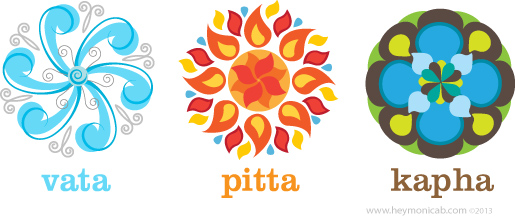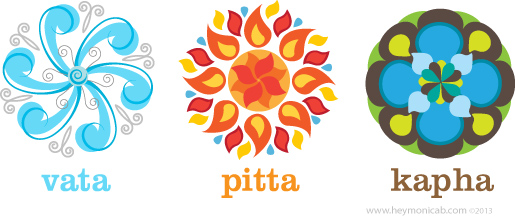 A dosha is a Sanskrit term that represents one of the main concepts behind traditional Ayurvedic medicine. It is sometime referred to as a “bodily humor” in English, but even this has vague meaning.
A dosha is a Sanskrit term that represents one of the main concepts behind traditional Ayurvedic medicine. It is sometime referred to as a “bodily humor” in English, but even this has vague meaning.
A dosha is a subtle, energetic, biological force that governs our actions, physical characteristics, personalities and mental/emotional functioning. There are 3 doshas that reside in the body known as Vata, Pitta and Kapha; each of which is comprised and represented by 2 of the 5 main elements (Ether, Air, Fire, Water and Earth). Each dosha possesses unique qualities that reflect the qualities of their respected elements. Here is a complete list of the specific qualities (gunas) each dosha carries:
Vata: Air and Space
- Light (laghu)
- Cold (shita)
- Rough (khara)
- Dry (ruksha)
- Mobile (chala)
- Clear (vishada)
- Subtle (sukshma)
- Brownish/blackish
Pitta: Fire and Water
- Hot (ushna)
- Sharp, penetrating (tikshna)
- Light (laghu)
- Liquid (drava)
- Oily (snigdha)
- Spreading (sara)
- Fleshy smell
- Red, yellow, orange
Read more on Pitta dosha here.
Kapha: Water and Earth
- Heavy (guru)
- Cool (hima)
- Slow, dull (manda)
- Slimy, smooth (shlakshna)
- Dense (sandra)
- Soft (mrudu)
- Cloudy (avila)
- Sticky (picchila)
- Hard (kathina)
- Gross (sthula)
- Oily (snigdha)
- Liquid, damp (drava)
- Stable, static (sthira)
- White
Read more on Kapha dosha here.
So how do these doshas relate to us?
Just as we possess all 5 elements in the body, we also possess all 3 doshas (no ifs, ands or buts!). What makes us unique is the ratio of each dosha that is present in our physiological and psychological makeup. The specific ratio of these 3 doshas is known as our Prakruti or “natural born constitution” and this ratio will never change throughout our entire lives (except in the very rare circumstances). However, it is quite typical to have an imbalance of doshas, known as Vikruti, and this is only a temporary, altered state until balance is regained.
A persons Prakruti or constitution is typically referred to as being Vata, Pitta or Kapha “predominant”, depending on the individual. They then will have a “secondary” dosha which is fairly strong, but not quite as strong as the “predominant” dosha. Then finally there is the third dosha, that may be seemingly non-existent in one’s constitution, but it is indeed there, just not quite as obvious.
A person with a Kapha predominant nature, Pitta secondary and Vata least will then be written as followed: Vata 1, Pitta 2, Kapha 3. As you can see, 3 represents the strongest dosha, 2 the secondary and 1 the least.
Of course, it is possible for a person to have 2 predominant doshas, which means that 2 doshas are just about equally as strong and predominant. For example, if one is predominant in both Vata and Pitta with Kapha as the secondary, it is shown as this: Vata 3, Pitta 3, Kapha 2. This is termed as being “dual-doshic” and is in fact a fairly common phenomenon (including in my own personal Pitta/Vata constitution!). It is even said to be possible to be “tri-doshic” in which all 3 doshas are equally strong and predominant, but this is extremely uncommon. In fact, my teacher whom has been studying and practicing Ayurveda for 60 years has never personally seen this in any individual.
Why is it important to know your dosha?
To understand your doshic ratio is huge is terms of obtaining the proper dietary, lifestyle and overall health habits. If you are able to discover which dosha(s) is predominant in your constitution, you can then discover which foods are best for you, which foods to avoid, which lifestyle practices are best for you, ideal times for eating and sleeping, herbs that will heal you and herbs that will create further imbalance… and the list goes on! When you know the dosha(s) and the specific qualities that are strong in your constitution, you can then see how to create and maintain balance in your everyday life!



I have a question about determining your constitution if you get different pulse readings. I went to see an Ayurvedic practitioner about ten years ago. My intuition told me her diagnosis was wrong, but I followed the dosha guidelines faithfully. It made me much sicker. A few years later I was getting body work from a woman who was an Ayurvedic practitioner and she took my pulse out of curiosity. What she found was dramatically different from the first practitioner, though her impression from my appearance was the same as the first woman’s. But the second diagnosis didn’t ring true either. Other than skill, are there other factors that can get in the way of an accurate diagnosis?